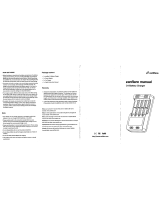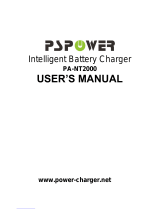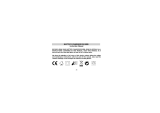Page is loading ...

1
Battery Charger BT-C3100 OPERATING INSTRUCTIONS
1. Intended Use
The product is intended to charge and discharge NiCd, NiMH or
3.7v Li-ion rechargeable batteries in size type of 16340, 10440, 14500,
16340, 18500, 18650, 26650, 26500. It provides four independent
charging slots for rechargeable batteries. The charger can also
optimize and test the maximum capacity of the rechargeable
batteries. Each charging slot has its own display to show various
information, such as, charging current, battery voltage, charged
capacity, battery internal resistance and elapsed charging time.
The charging current can be selected for 200mA, 300mA, 500mA ,
700mA, and 1000mA ( if only bay 1 and/or 4 are used to charging
batteries, current 1500mA and 2000mA can be further selected).
Default charging current is 500mA.
Discharging current can be selected between 200mA, 300mA, 500mA,
700mA and 1000mA. Default discharging current is 500mA
The charger can charge batteries of different type and size and with
different capacity at the same time. It also integrates the minus delta
voltage (-ΔV) for NiCd or NiMh battery charging termination, and for
Li-ion batteries charging to 4.2V with pre-selected constant current.
When battery is fully charged, the charger will switch to trickle
charging automatically. Therefore battery will be kept at its optimum
capacity. The charger also includes overheat detection to protect
rechargeable batteries and charger itself from overheating. When
temperature sensor detects PCB or battery voltage is over 40 degrees
Celsius, then the fan will be turned on automatically. Only when all 6
temperature sensors temperature is measured less than 40 degrees
Celsius, then the fan will be switched off.
The charger can only be powered by power supply rated 12v/3.0A.
Operate and store it in dry indoor environment only.
This product fulfills European and national requirements related to
electromagnetic compatibility (EMC). CE conformity has been verified
and the relevant statements are available upon request.
Unauthorized conversion and/or modification of the device are
inadmissible because of safety and approval reasons (CE). Any usage
other than described above is not permitted and can damage the
product and lead to associated risks such as short-circuit, fire, electric
shock, etc. Please read the operating instructions thoroughly and
keep them for future reference.
The charger has its backlight turned on after each key press. Back
light will be switched off after 30 seconds when no key is pressed.
The maximum charging capacity can be up to 20,000mAH.
2. Delivery Content
Battery Charger BT-C3100 1pcs
Power Adapter 1pcs
Operation Instructions 1pcs
3. Safety Instructions
We do not assume liability for resulting damages to property or
personal injury if the product has been abused in any way or
damaged by improper use or failure to observe these operating
instructions. The warranty will then expire!
3.1 Product Safety
The product must not be exposed to substantial mechanical
strain or strong vibrations.
The product must be protected against electromagnetic fields,
static electrical fields, extreme temperatures, direct sunlight and
moisture
The manufacturer’s instruction for the respective batteries
must be observed, before they are charged.
The product should not be connected immediately after it has
been brought from an area of cold temperature to an area of
warm temperature. Condensed water might destroy the
product. Wait until the product adapts to the new ambient
temperature before use.
Sufficient ventilation is essential when operating the charger. Never
cover the ventilating slots of the charger, especially area in front of
the cooling fan need to be at least 8cm free open area for enough
ventilation purpose. Please take cautions especially when ambient
temperature is over 35 degrees Celsius and charging current rate is
over 0.5C. If higher charging current applied, it is more easy to build
up temperature on batteries.
3.2 Battery Safety
Correct polarity must be observed while inserting the batteries.
Non-rechargeable batteries, rechargeable alkaline batteries
(RAM), lead acid batteries must not be charged with this
product. There is danger of explosion!
Batteries should be removed from the device if it is not used for
a long period of time to avoid damage through leaking. Leaking
or damaged batteries might cause acid burns when in contact
with skin, therefore use suitable protective gloves to handle
corrupted batteries.
Batteries must be kept out of reach of children. Do not leave the
battery lying around, as there is risk, that children or pets

2
swallow it.
Batteries must not be dismantled, short-circuited or thrown into
fire. Never recharge non-rechargeable batteries. There is a risk
of explosion!
Repair works must only be carried out by a specialist/specialist
workshop.
If you have queries about handling the device, which are not
answered in this operating instruction, please check with the
distributor for further help.
4. Operating Elements
5. Power Supply
The shipped power adapter is the power supply for this charger. In
case you need to use other power adapter, please be aware that
power supply has the correct polarity plug. Also please be noted that
power supply need be able to supply minimum 3.0A current. Low
output power adapter could lead to working improperly.
Then all LCD segments will light up momentarily. “null” will be
shown until any batteries are inserted.
6. Operation
Once a rechargeable battery is inserted, its present voltage( for
example, “1.12v”) will be displayed for 3 seconds, then 500mA
default charging current will be shown on display for another 3
seconds. If MODE or CURRENT button is not pressed during this 6
seconds, charging process will start. During the first 6 second time, If
any button is pressed, the unit will wait for another 10s before
finishing current slot setting. Press “SLOT” button will confirm the
setting right way without the needs of waiting the 10s auto time-out
time elapsed. All other battery can be handled the same. So each
battery can have its own setting independently.
While the previous battery slot setting mode is in effective (telling by
the flashing display of that battery slot LCD ), and the next battery is
inserted, then both battery slot display will be flashing, which means
that any setting change will be applied for all batteries in setting
mode at the same time.
Once start normal working mode, charging current can no longer be
changed unless its working mode is changed or batteries are taken
out from charger and insert into charger again.
During normal working mode, if no particular slot is selected by
pressing the SLOT button, MODE, CURRENT and DISPLAY button are
always referring to 4 slots simultaneously. If a different working or
display mode is desired for particular slot, press the SLOT button to
select the slot and then
press “Mode” or “Display” to select your wanted working or
display mode..
6.1 Mode Selection
Press and hold the “MODE” button for 2 seconds to start
working mode selection for all four battery slot.
Press the “MODE” button subsequently to toggle among the
“Charge”, ”Discharge”, ”Test” , “Quick Test” and
“Refresh” mode
When particular slot working mode need to be changed, press
SLOT button to select the desired slot and then press MODE
button to choose wanted working mode.
When working mode is changed, working current adjustment is
possible.
6.2 Current Selection
Within the first 6 seconds after inserting the battery or right after
power up, press the “CURRENT” button to select desired charge
current for slots loaded with battery at the same time. Current setting
can not be altered once the setting has been confirmed in the initial
stage. If different working current is needed afterwards, either
changing the working mode or rechargeable battery must be taken
out and inserted again. Discharge current is set to the selected
charge current selected.
6.3 Display Selection
“DISPLAY” button is for toggling display information for voltage,
current, capacity, work time etc.

3
6.4 SLOT Selection.
This button is used to select desired slots for different working mode,
charge current or display mode. Press SLOT button will start the slots
selection processing in the sequence cycle of 1->2->3->4->4
slots->exit.
7. Overheat Protection
When charger works at high current, there will be massive heat
generated inside the charger. To achieve a good charging result as
well as keeping batteries at the top condition, lowest temperature
rise is very important for both charger and battery. BT-C3000 charger
is equipped with a temperature controlled cooling system. When
internal temperature is lower than 40C, fan will be stopped. When
internal temperature or battery temperature is over 40C, fan will be
switched on.
With our improved charging circuit design, for normal good quality
battery with low impedance, heating built up on battery during
charging process is almost unnoticeable. However during the last
charging stage for Ni-Cd or Ni-Mh batteries, when battery is almost
full, batteries can become hot. This is normal: the larger charging
current applied, the more heat will build up. When battery
temperature is sensed to be over 60C, then over heat protection will
be kicked in for safety reason. When overheating occurs, current
working mode for all 4 slots will be automatically halted. To tell if it is
in the state of overheating protection mode, charging current will be
reduced to 0mA.
Charging/discharging process will only resume after battery
temperature drops below 40 degrees Celsius.
8. Operation Modes and Display
8.1 Operation Modes:
Charge Mode: The rechargeable battery is charged up to its
maximum capacity. Accumulated charging capacity is
displayed at mAH display mode. For Ni-MH or Ni-Cd
batteries, after charging mode is completed, a trickle charge
current (around 10mA) will be applied. For Li-ion battery,
once charge mode is completed, no trickle charge current
will be applied. When Li-ion battery voltage is dropped less
than 4.0v, then charging will be activated until battery
voltage reaches 4.20v.
Discharge Mode: It is used to reduce the memory effect. The
rechargeable battery is discharged to a preset battery
voltage (0.9v for Ni-Cd & Ni-Mh, 2.8v for Li-ion batteries).
Once discharge is finished, total accumulated discharging
capacity is displayed at mAH display mode, showing how
much energy is discharged from the battery, which is always
referring to the accumulated discharging capacity. Trickle
charge current will be applied after discharge cycle is
finished, preventing the batteries from discharging any
further.
Refresh Mode: The rechargeable battery is charged and
discharged repeatedly to optimize to its maximum capacity.
Old rechargeable batteries or rechargeable batteries that
have not been used for a long period of time can be
restored to their rated capacity. Depends on the selected
charge current and battery impedance, it can take tens hours
or even days time before complete. Refresh mode will make
3 complete discharge-charge working cycles before
complete. After charge cycle is complete, the total charged
capacity will be displayed in mAH display mode even it is at
discharging stage of that cycle.
Test mode: Checks the present capacity of a rechargeable
battery. The maximum capacity is determined by discharging
the rechargeable battery after it was fully charged. If the
maximum capacity is much lower than the rated capacity
then it may reach the end of its lifetime.
Quick Test mode: The charger will analyze the dynamic
internal battery resistance by applying a load and the current
reading is referred to the voltage drop detected on the
battery. Within 10s, the tested battery resistance will be
displayed in the unit of milliohm. For good quality batteries,
the internal resistance is very low: in the range of 20 ~ 80
milliohms. If battery internal resistance is over 500milliohms,
then these batteries are not good for supplying power to
high current loads, such as digital camera etc. But they can
still be used for low energy loads, such as clock, remote
controllers etc. Always use batteries with close internal
resistance range when they are used in serial to achieve
maximum battery life. Alkaline and any other 1.5v batteries
can be tested on this charger as well. If a completely empty
battery is to be tested, it is not possible to give any correct
reading. Please be noted that since the internal battery
resistance can be very small, and contact resistance can be a
major influence factor, thus same battery tested in different
slot or even at the same slot with different contact condition,
the reading can be varied for 10% to 20%. This is normal.
Test twice if needed to assure a correct measurement result.

4
Due to the construction reason, there is around 30milliohm
contact resistance from the charger itself, and this resistance
is calculated together with battery internal resistance. It
should be deducted from the reading to get a more accurate
battery resistance reading.
When a high impedance battery( eg. Over 2500milli ohm) is
loaded onto the charger, due to its high internal impedance,
real displayed charging current can be much less than your
pre-selected charging current. When this happened, it
doesn’t means the charger is defective. Eventually it needs
longer charging time until fully charged.
8.2 Display
Charge/Discharge Current: instantaneous current is displayed.
Time Elapsed: The charging/discharging time of the last cycle is
displayed.
Accumulated Capacity: The accumulated battery capacity is
displayed in mAh. For discharge mode, it is referring to the
accumulated energy discharged from that battery. For refresh
mode, previous charging capacity is displayed even when
current working stage is at discharge cycle.
Battery Voltage: The instantaneous battery voltage is displayed.
At QUICK TEST mode, it shows the internal battery resistance in
mili- ohm(0.001R).
Full: After the rechargeable battery is fully charged in any of the
operation modes, trickle charging will be started automatically.
Trickle charging prevents the rechargeable batteries from being
overcharged and compensates for self-discharging of the
batteries
9. Maintenance
The device is maintenance-free but should be cleaned occasionally.
When cleaning, the device must be removed from any power source.
Only use dry and soft cloth to clear the housing of the charger. Do
not use abrasive or solvents.
10. Disposal
10.1 Disposal of waste electrical and electronic equipment
In order to preserve, protect and improve the quality of environment,
protect human health and utilize natural resources prudently and
rationally, the user should return unserviceable product to relevant
facilities in accordance with statutory regulations.
The crossed-out wheeled bin indicates the product needs to be
disposed separately and not as municipal waste.
10.2 Used batteries/rechargeable batteries disposal
The user is legally obliged (battery regulation) to return used
batteries and rechargeable batteries. Disposing used batteries in the
household waste is prohibited! Batteries/rechargeable batteries
containing hazardous substances are marked with the crossed-out
wheeled bin. The symbol indicates that the product is forbidden to be
disposed via the domestic refuse. The chemical symbols for the
respective hazardous substances are Cd= Cadmium, Hg = Mercury,
Pb = Lead.
You can return used batteries/rechargeable batteries free of charge to
any collecting point of your local authority.
11. Technical Data
Operating Voltage
12V DC
Power Adapter
Input:
100~240V~, 50/60Hz
Output:
12V DC, 3.0A
Charging Current range
200,300,500,700,1000,1500,2000
Discharging Current
range
200,300,500,700,1000mA
Max. Charging Capacity
20000mAh
Operating Temperature
0 to 40 ℃
Voltage Deviation
<0.04v
Current Deviation
<5%
/





